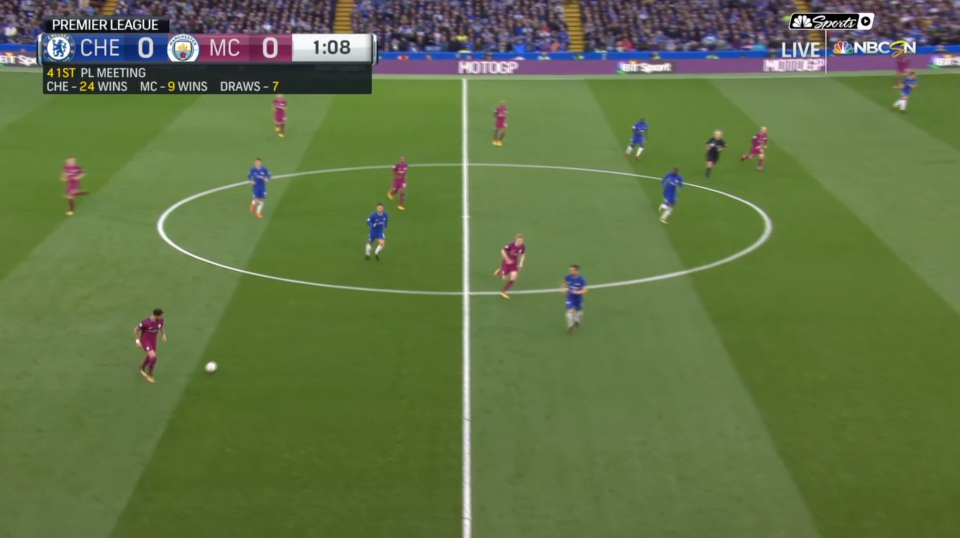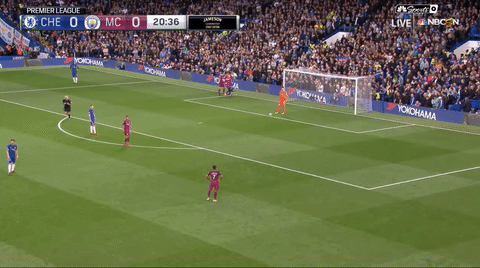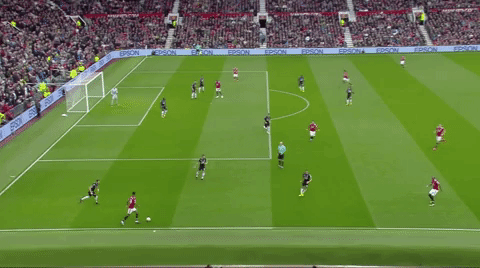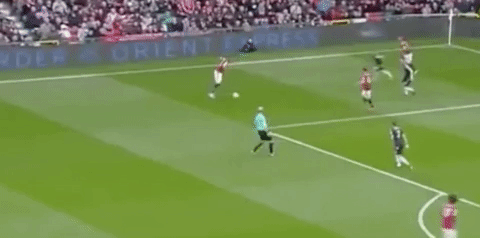2017-18 Premier League DARTS, Week 7: City's brilliance, its Chelsea chess, and 'the Harry Kane team'

In the end, football, or soccer, or whatever you prefer to call it, is without purpose if it does not at some point bring joy.
However you choose to invest in the game, whether emotionally as a fan or physically as a player or otherwise, sacrifice is necessary. Heartbreak is accepted as a necessary side-effect. Joy, though, is the reason we are drawn to the sport. The reason we invest. The reason we suffer.
Those that bring us joy, therefore, must be celebrated. And nobody has delivered more joy through seven weeks of the Premier League season than Manchester City.
Specifically, nobody has delivered more joy over a 90-minute stretch than the 11 players that donned magenta Manchester City away kits on Saturday at Stamford Bridge. They confronted a compact, conservative version of arguably the world’s best defensive unit with audaciousness and vigor. They picked it apart with artistry and wit. Their dominance was not absolute. But their approach to the game was irresistible.
Their performance was one for aesthetes and connoisseurs, for philosophers and scholars, for inebriated middle-aged men and women screaming at pub TVs in East Manchester, and for casual fans relaxing on couches across America. It was not perfect. It was not always fast-paced or clinical. But it brought an irrepressible smile to my face, and hopefully it did similarly to yours.
City is the best team the Premier League has seen in a while. That does not mean it will rip records to shreds. It does not even mean the Citizens will win the league. But it does mean we should appreciate what we are watching. Appreciate Pep. Appreciate a ginger Belgian genius. Appreciate football that is equal parts intense, beautiful and effective.
And we can start by appreciating a victory over the defending Premier League champions that resembled a breakneck, high-stakes game of chess.
1. The threat and subsequent adjustment that enabled City’s backbreaker
After 20 minutes, Antonio Conte had seen enough. Enough of City’s passing and probing. Enough of Pep Guardiola’s tactical wrinkles. And he realized he had to make a change.
Chelsea was stretched horizontally by a City formation that did not take the same shape on the field that it did on paper. It was at times the expected 4-3-3 without the ball. But with the ball, City shifted into a 3-4-3 that morphed into different variations throughout the game.
Most commonly, the midfield took a diamond shape. Fabian Delph, the nominal left back, moved into a central left midfield position, beside Fernandinho. De Bruyne was to the right of Fernandinho. David Silva was ahead of him. Kyle Walker, the right back, stayed at home in a back three alongside John Stones and Nicolas Otamendi.

Walker would occasionally push into midfield as well. The inverting of the fullbacks – a tactic Pep employed early last season, and previously at Bayern Munich – made City’s counterpress suffocating. It allowed them to recycle possession when attacks stalled.
It also gave the Citizens a 4-v-3 in midfield that Chelsea couldn’t quite sort out early on. De Bruyne and Delph would spread wide to stretch Chelsea’s three.

City would circulate the ball side-to-side through Fernandinho or the back three, forcing Chelsea to shift with it. N’Golo Kante, playing on the right of Chelsea’s three, was matched up with Delph. That left Fabregas, playing on the left, to deal with De Bruyne. City recognized the mismatch, and Silva often drifted out right to overload Fabregas’ side. With Marcos Alonso pinned back by Raheem Sterling, De Bruyne or Silva had the space to launch attacks.

Conte realized an adjustment was necessary, and during a 21st-minute injury stoppage, he made it. He swapped Fabregas and Bakayoko, hiding the former in between Kante and the latter. You can see the switch taking place here (bottom left):

For 40 subsequent minutes, Chelsea was relatively solid. It pulled back its line of confrontation to protect Fabregas. It tweaked its defensive rotations to allow Gary Cahill or Antonio Rudiger to step out of the back three and neutralize the overloads. The middle third of the game was relatively uneventful – which, after Alvaro Morata went off injured, was exactly how Conte wanted it.
But on 66 minutes, the very adjustment that had allowed the hosts to cope with City came back to bite them. Ignore City’s five perfect touches for a second, and zero in on Fabregas:
He might as well have been a training dummy. He was as stationary as a “defensive midfielder” can be. Conte tried to safeguard him. Otamendi and De Bruyne sought him out. Five seconds later, the ball was in the net.
In the end, the adjustment made the goal possible. There is no escaping that. No two ways about it. But Conte was in a bind. The adjustment itself was not the source of the problem. City’s quality and tactical nous forced the switch. It was those two things that won the day.
2. Kevin De Bruyne, the one that got away
It also, of course, was De Bruyne, a top-three player in the Premier League, and one who is intimately familiar with the ground he silenced on Saturday. Stamford Bridge was the site of De Bruyne’s first Premier League goal, on the opening day of the 2013-14 season.
Back then, of course, De Bruyne was wearing Chelsea blue.
But he only wore it nine times, for 425 minutes, and only two more times in the league after his debut goal. He departed permanently in January, a casualty of the club’s book-balancing strategy to buy and sell young players for profit. De Bruyne might as well have been one of the transfer policy’s poster boys, bought from Genk as a 20-year-old for £7 million, sold on two years later for £18 million. A sterling example of how the scheme works.
And now a guilt-inducing example of how it can backfire.
The system is in place with an acknowledgement that there will be some misses. No matter the number or extent of the misses, it still serves its purpose. But this was a big miss. An internal scouting failure. De Bruyne was the Bundesliga player of the year his first full season away from Chelsea. Eighteen months after the Blues sold him for an £11 million profit, Wolfsburg pocketed a net £37 million. And the club-record £55 million that City paid over two years ago has absolutely been worth it.
“He is the complete player,” Conte acknowledged in defeat.
Pep was even more effusive. “He is good in small spaces,” Guardiola gushed. “He has speed, fight and can attack through the channel.
“He can do absolutely everything.”
3. The title race, and “the Harry Kane team”
City, as a team, can seemingly do absolutely everything right now. But they aren’t alone. With Manchester United stomping Crystal Palace on Saturday, the two Manchester clubs are separated by a single goal. Guardiola might not have known about United’s fourth four-nil of the season, but he knows that the title scrap will be arduous.
“Jose with United will always be tough,” he said Saturday. “That is a Jose Mourinho team, aggressive winning duels and so quick on the counterattack. They are already convinced they can do it in this way. It will be tough.”
It is difficult to assess the title race seven weeks in, because United’s schedule has been incredibly soft. Its seven opponents currently sit 12th, 13th, 15th, 16th, 17th, 18th and 20th in the table. City, on the other hand, has already beaten two of the Big Six. But a cross-town battle for the Premier League sure does appear to be shaping up.
And if there is to be an interloper? It appears Pep has a prediction for who that might be.
“We have United,” he said, “[and] the Harry Kane team who scores every game two or three goals.”
4. Is the Tottenham player a top-10 striker in the world? Top-five?
Kane was fantastic on Saturday – and has been fantastic all month. He scored seven goals in an eight-day stretch, and has bagged 11 in his past six games. He’s now scored as many goals in 2017 as West Ham.
Heck, he’s been fantastic for a long time now, basically ever since his “one-year wonder” season. So where does he rank among the world’s best strikers?
It depends on whom you classify as a striker. If we’re being all-inclusive, he’s still behind Lionel Messi, Cristiano Ronaldo, Robert Lewandowski, Pierre-Emerick Aubameyang and probably Luis Suarez. Probably Antoine Griezmann too. But I’d slot him in at No. 7 – ahead of, among others, Romelu Lukaku, Sergio Aguero, Gabriel Jesus, Edinson Cavani, Gonzalo Higuain and Diego Costa. Feel free to tell me that I’m wrong.
5. Kane is legit; so is Marcus Rashford
Excuse me while I write a love letter to Rashford, disguised as an analytical look at United’s first goal on Saturday. Because everything about the 19-year-old’s involvement in that goal is so darn impressive.
First of all, merely getting on the end of Ashley Young’s through-ball required loads of ability. Watch how Rashford angles his run to make a bit of contact with Joel Ward to ensure the Palace right back can’t cut out the pass:

And then the “get off me” shoulder feint:

And then the cut. Let’s talk about the cut. Because it’s a deceivingly difficult skill to pull off. The vast majority of professional soccer players make this same fake-cross cut in two motions. Young does it as much as anybody. The first motion accentuates the fake and ends in a split-second pause. The second motion brings the ball back across the attacker’s body.

Rashford does it all in one motion, and that’s why he gets so much separation.

The separation gives him the time and space to pick out Mata.
6. Crystal Palace’s season, in one GIF
Rashford went 71 minutes. Anthony Martial replaced him, which is just unfair. And within a minute of his introduction, Martial ended Andros Townsend’s career. Just watch the reaction:

7. Leicester continues to leave £55 million worth of strikers on the bench
In news related to that subhead, Leicester drew 0-0 with 19th-place Bournemouth on Saturday. Kelechi Iheanacho made a second-half cameo. Islam Slimani did not. Through seven Premier League games, the most expensive players in the history of Leicester City Football Club have combined for two starts.
Manager Craig Shakespeare apparently feels that Shinji Okazaki is a better partner for Jamie Vardy up top, which is a defensible opinion. But that determination and the decisions to buy Slimani (£30 million last summer) and Iheanacho (£25 million this summer) clash. Either Shakespeare is egregiously mismanaging his squad, or the club’s recruitment strategy is egregiously flawed. Or both.
These are exactly the kind of mistakes that keep the Premier League’s hierarchy as it is. Leicester had a unique opportunity in 2016 to use its stunning success to establish itself in the Premier League’s upper tier, or at least right below it. And the club has spent enough money to at least firm up a position as the best of the non-elite. But when you fail to address issues in midfield and defense, and instead recklessly hurl £55 million at two players who don’t fill needs … well, you end up here, having survived a relegation battle last season, and possibly set for another one this time around.
8. Someone save Salomon Rondon
Please. Before it’s too late. The Venezuelan striker is really good. He was great for two seasons under Manuel Pellegrini at Malaga early this decade. Somehow, though, he only parlayed that success into four years in Russia and two-plus seasons at West Brom.
Sure, he might not be Premier League Big Six material. And at 28, the inflection point of his career arc has probably passed. But it would be lovely to see him get a shot with a more relevant, more attack-minded team. Let Saturday’s opener against Watford serve as an example of what he can do.
9. Recalibrating our projected table after two months
Two notable scores not discussed above were Everton’s 1-0 home loss to Burnley, and Liverpool’s 1-1 draw at Newcastle. The results, in a way, were extensions of early-season form for all four teams. No team has sunk lower through two months than Everton. No two teams have risen higher over the past four weeks than Burnley and Newcastle.
But how low? How high?
Three weeks into the season, we recalibrated our projected league table. Heading into 2017-18’s second international break, it’s time to do so again:
First number in parentheses is the difference between preseason prediction and current prediction; second number as the change since Week 3.
1. City (-|-)
2. United (-|-)
3. Tottenham (-|-)
4. Chelsea (-|-)
5. Liverpool (-|-)
6. Arsenal (-|-)
7. Newcastle (+6|+6)
8. Southampton (-1|-1)
9. Watford (+7|+2)
10. Stoke (+1|-)
11. Everton (-3|-3)
12. West Brom (+2|-)
13. Burnley (+6|+5)
14. Leicester (-2|-5)
15. West Ham (-6|-1)
16. Huddersfield (+4|-1)
17. Crystal Palace (-7|-1)
18. Bournemouth (-3|-1)
19. Swansea (-1|-)
20. Brighton (-3|-)
– – – – – – –
Henry Bushnell covers soccer – the U.S. national teams, the Premier League, and much, much more – for FC Yahoo and Yahoo Sports. Have a tip? Question? Comment? Email him at henrydbushnell@gmail.com or follow him on Twitter @HenryBushnell.


